Spatial–Temporal Variation Characteristics of Multiple Meteorological Variables and Vegetation over the Loess Plateau Region
Abstract
:1. Introduction
2. Experiment Description
2.1. Study Area and Data Used
2.2. Methodology
3. Results
3.1. Vegetation Distribution over the Loess Plateau
3.2. Analysis of Meteorological Factors
3.2.1. Spatial Distribution of Precipitable Water Vapour over the Loess Plateau
3.2.2. RHU and SSD
3.3. Change in Extreme Climatic Indices over the Loess Plateau Region
3.4. Correlation Analysis
3.4.1. NDVI and Meteorological Factors
3.4.2. Correlations between Meteorological Factors and Extreme Climatic Indices
3.4.3. NDVI and Extreme Climate Indices
3.5. Time Lag Effect
4. Discussion
5. Conclusions
Author Contributions
Funding
Acknowledgments
Conflicts of Interest
References
- Stocker, T.; Plattner, G.K.; Dahe, Q. IPCC climate change 2013: The physical science basis—Findings and lessons learned. In Proceedings of the EGU General Assembly Conference, Vienna, Austria, 27 April–2 May 2014. [Google Scholar]
- Solomon, S. IPCC climate change: The physical science basis. Clim. Chang. Phys. Sci. Basis 2007, 9, 123–124. [Google Scholar] [CrossRef]
- Planton, S.; Déqué, M.; Chauvin, F.; Terray, L. Expected impacts of climate change on extreme climate events. Comptes Rendus Géosci. 2008, 340, 564–574. [Google Scholar] [CrossRef]
- Omondi, P.A.O.; Awange, J.L.; Forootan, E.; Ogallo, L.A.; Barakiza, R.; Girmaw, G.B.; Fesseha, I.; Kululetera, V.; Kilembe, C.; Mbati, M.M.; et al. Changes in temperature and precipitation extremes over the greater horn of Africa region from 1961 to 2010. Int. J. Climatol. 2014, 34, 1262–1277. [Google Scholar] [CrossRef]
- Pepler, A.; Coutts-Smith, A.; Timbal, B. The role of East Coast Lows on rainfall patterns and inter-annual variability across the East Coast of Australia. Int. J. Climatol. 2014, 34, 1011–1021. [Google Scholar] [CrossRef]
- Yilmaz, A.G. The effects of climate change on historical and future extreme rainfall in Antalya, Turkey. Hydrol. Sci. J. 2015, 60, 2148–2162. [Google Scholar] [CrossRef] [Green Version]
- Teufel, B.; Diro, G.T.; Whan, K.; Milrad, S.M.; Jeong, D.I.; Ganji, A.; Huziy, O.; Winger, K.; Gyakum, J.R.; de Elia, R.; et al. Investigation of the 2013 Alberta flood from weather and climate perspectives. Clim. Dyn. 2017, 48, 2881–2899. [Google Scholar] [CrossRef] [Green Version]
- Deng, H.; Chen, Y.; Shi, X.; Li, W.; Wang, H.; Zhang, S.; Fang, G. Dynamics of temperature and precipitation extremes and their spatial variation in the arid region of northwest China. Atmos. Res. 2014, 138, 346–355. [Google Scholar] [CrossRef]
- Rao, B.B.; Chowdary, P.S.; Sandeep, V.M.; Rao, V.U.M.; Venkateswarlu, B. Rising minimum temperature trends over India in recent decades: Implications for agricultural production. Glob. Planet. Chang. 2014, 117, 1–8. [Google Scholar]
- Xiao, X.; Boles, S.; Liu, J.; Zhuang, D.; Liu, M. Characterization of forest types in Northeastern China, using multi-temporal SPOT-4 VEGETATION sensor data. Remote Sens. Environ. 2002, 82, 335–348. [Google Scholar] [CrossRef]
- Pettorelli, N.; Vik, J.O.; Mysterud, A.; Gaillard, J.M.; Tucker, C.J.; Stenseth, N.C. Using the satellite-derived NDVI to assess ecological responses to environmental change. Trends Ecol. Evol. 2005, 20, 503–510. [Google Scholar] [CrossRef]
- Zhou, G.; Zhang, X. Study on Chinese climate-vegetation relationship. Acta Phytoecol. Sin. 1996, 20, 113–119. [Google Scholar]
- Gornall, J.; Betts, R.; Burke, E.; Clark, R.; Camp, J.; Willett, K.; Wiltshire, A. Implications of climate change for agricultural productivity in the early twenty-first century. Philos. Trans. R. Soc. Lond. 2010, 365, 2973–2989. [Google Scholar] [CrossRef] [PubMed]
- Bokhorst, S.; Tømmervik, H.; Callaghan, T.V.; Phoenix, G.K.; Bjerke, J.W. Vegetation recovery following extreme winter warming events in the sub-Arctic estimated using NDVI from remote sensing and handheld passive proximal sensors. Environ. Exp. Bot. 2012, 81, 18–25. [Google Scholar] [CrossRef]
- Sun, J.; Cheng, G.; Li, W.; Sha, Y.; Yang, Y. On the variation of NDVI with the principal climatic elements in the Tibetan Plateau. Remote Sens. 2013, 5, 1894–1911. [Google Scholar] [CrossRef] [Green Version]
- Hu, Z.; Li, Q.; Chen, X.; Teng, Z.; Chen, C.; Yin, G.; Zhang, Y. Climate changes in temperature and precipitation extremes in an alpine grassland of Central Asia. Theor. Appl. Climatol. 2015, 126, 519–531. [Google Scholar] [CrossRef]
- Zhao, A.; Zhang, A.; Liu, X.; Cao, S. Spatiotemporal changes of normalized difference vegetation index (NDVI) and response to climate extremes and ecological restoration in the Loess Plateau, China. Theor. Appl. Climatol. 2018, 132, 555–567. [Google Scholar] [CrossRef]
- Guo, W.Q.; Yang, T.B.; Dai, J.G.; Shi, L.; Lu, Z.Y. Vegetation cover changes and their relationship to climate variation in the source region of the Yellow River, China, 1990–2000. Int. J. Remote Sens. 2008, 29, 2085–2103. [Google Scholar] [CrossRef]
- Sun, W.; Mu, X.; Song, X.; Wu, D.; Cheng, A.; Qiu, B. Changes in extreme temperature and precipitation events in the Loess Plateau (China) during 1960–2013 under global warming. Atmos. Res. 2016, 168, 33–48. [Google Scholar] [CrossRef]
- Liu, W.; Zhang, M.; Wang, S.; Wang, B.; Li, F.; Che, Y. Changes in precipitation extremes over Shaanxi Province, northwestern China, during 1960–2011. Quat. Int. 2013, 313-314, 118–129. [Google Scholar] [CrossRef]
- Rangwala, I.; Miller, J.R.; Ming, X. Warming in the Tibetan Plateau: Possible influences of the changes in surface water vapor. Geophys. Res. Lett. 2009, 36, 295–311. [Google Scholar] [CrossRef] [Green Version]
- Immerzeel, W.W.; Van Beek, L.P.; Bierkens, M.F. Climate change will affect the Asian water towers. Science 2010, 328, 1382–1385. [Google Scholar] [CrossRef] [PubMed]
- Yang, K.; Ye, B.; Zhou, D.; Wu, B.; Foken, T.; Qin, J.; Zhou, Z. Response of hydrological cycle to recent climate changes in the Tibetan Plateau. Clim. Chang. 2011, 109, 517–534. [Google Scholar] [CrossRef]
- Yao, Y.; Shan, L.; Zhao, Q. Establishing a method of short-term rainfall forecasting based on GNSS-derived PWV and its application. Sci. Rep. 2017, 8, 12465. [Google Scholar] [CrossRef] [PubMed]
- Xu, X.; Lu, C.; Shi, X.; Gao, S. World water tower: An atmospheric perspective. Geophys. Res. Lett. 2008, 35, 525–530. [Google Scholar] [CrossRef]
- Manandhar, S.; Dev, S.; Lee, Y.H.; Meng, Y.S.; Winkler, S. A Data-driven approach to detecting precipitation from meteorological sensor data. In Proceedings of the IEEE International Geoscience and Remote Sensing Symposium (IGARSS), Valencia, Spain, 22–27 July 2018; pp. 3872–3875. [Google Scholar]
- Wang, F.; Mu, X.; Li, R.; Fleskens, L.; Stringer, L.C.; Ritsema, C.J. Co-evolution of soil and water conservation policy and human-environment linkages in the Yellow River Basin since 1949. Sci. Total. Environ. 2015, 508, 166–177. [Google Scholar] [CrossRef] [PubMed] [Green Version]
- Gui, K.; Che, H.Z.; Chen, Q.L.; Zeng, Z.L.; Liu, H.Z.; Wang, Y.Q.; Zheng, Y.; Sun, T.Z.; Liao, T.T.; Wang, H.; et al. Evaluation of radiosonde, MODIS-NIR-Clear, and AERONET precipitable water vapor using IGS ground-based GPS measurements over China. Atmos. Res. 2017, 197, 461–473. [Google Scholar] [CrossRef]
- Palmer, T.N.; Barkmeijer, J.; Buizza, R.; Petroliagis, T. The ECMWF ensemble prediction system. Meteorol. Appl. 2010, 4, 301–304. [Google Scholar] [CrossRef] [Green Version]
- Tucker, C.J.; Newcomb, W.W.; Dregne, H.E. AVHRR data sets for determination of desert spatial extent. Int. J. Remote Sens. 1994, 15, 3547–3565. [Google Scholar] [CrossRef]
- Wei, F.Y. Modern Climatic Statistical Diagnosis and Prediction Technology; China Meteorological Press: Beijing, China, 2007; Volume 63, p. 117. [Google Scholar]
- Guo, R.; Li, F.; He, W.; Yang, S.; Sun, G. Spatial and temporal variability of annual precipitation during 1958–2007 in Loess Plateau, China. In Proceedings of the Computer and Computing Technologies in Agriculture IV—IFIP Tc 12 Conference, Ccta 2010 Selected Papers, Nanchang, China, 22–25 October 2010; pp. 551–560. [Google Scholar]
- Lee, J.J.; Kim, C.H. Roles of surface wind, NDVI and snow cover in the recent changes in Asian dust storm occurrence frequency. Atmos. Environ. 2012, 59, 366–375. [Google Scholar] [CrossRef]
- Gong, T.T.; Lei, H.M.; Yang, D.W.; Jiao, Y.; Yang, H.B. Effects of vegetation change on evapotranspiration in a semiarid shrubland of the Loess Plateau, China. Hydrol. Earth Syst. Sci. Discuss. 2014, 11, 13571–13605. [Google Scholar] [CrossRef] [Green Version]
- Liu, Y.; Liu, X.; Li, S.; Peng, J.; Wang, Y. Analyzing nonlinear variations in terrestrial vegetation in China during 1982–2012. Environ. Monit. Assess. 2015, 187, 722. [Google Scholar] [CrossRef] [PubMed]
- Nicholson, S.E.; Davenport, M.L.; Malo, A.R. A comparison of the vegetation response to rainfall in the Sahel and East Africa, using normalized difference vegetation index from NOAA AVHRR. Clim. Chang. 1990, 17, 209–241. [Google Scholar] [CrossRef]
- Li, Z.; Yan, F.; Fan, X. The variability of NDVI over northwest China and its relation to temperature and precipitation. J. Remote Sens. 2005, 4, 2275–2277. [Google Scholar]
- Camberlin, P.; Martiny, N.; Philippon, N.; Richard, Y. Determinants of the interannual relationships between remote sensed photosynthetic activity and rainfall in tropical Africa. Remote Sens. Environ. 2008, 106, 199–216. [Google Scholar] [CrossRef] [Green Version]
- Herrmann, S.M.; Anyamba, A.; Tucker, C.J. Recent trends in vegetation dynamics in the African Sahel and their relationship to climate. Glob. Environ. Chang. 2017, 15, 394–404. [Google Scholar] [CrossRef]
- Li, R.; Zhao, L.; Ding, Y.G.; Wang, S.; Ji, G.L.; Xiao, Y.; Liu, G.G.; Sun, L.C. Monthly ratios of PAR to global solar radiation measured at northern Tibetan Plateau, China. Solar Energy 2010, 84, 964–973. [Google Scholar] [CrossRef]
- Liu, B.; Henderson, M.; Zhang, Y.; Xu, M. Spatiotemporal change in China’s climatic growing season: 1955–2000. Clim. Chang. 2010, 99, 93–118. [Google Scholar] [CrossRef]
- Tang, X.; Miao, C.; Xi, Y.; Duan, Q.; Lei, X.; Li, H. Analysis of precipitation characteristics on the loess plateau between 1965 and 2014, based on high-density gauge observations. Atmos. Res. 2018, 213, 264–274. [Google Scholar] [CrossRef]
- Bei, X.; Buli, C.; Dongsheng, L.I.; Xueli, C. Temporal and spatial variations of precipitation in different climatic regions of the Loess Plateau. Sci. Soil Water Conserv. 2017. [Google Scholar] [CrossRef]
- Zhao, Q.; Yao, Y.; Yao, W. Studies of precipitable water vapour characteristics on a global scale. Int. J. Remote Sens. 2019, 40, 72–88. [Google Scholar] [CrossRef]
- Piao, S.; Friedlingstein, P.; Ciais, P.; Viovy, N.; Demarty, J. Growing season extension and its impact on terrestrial carbon cycle in the Northern Hemisphere over the past 2 decades. Glob. Biogeochem. Cycles 2007, 21. [Google Scholar] [CrossRef]
- Zhao, M.; Pitman, A.J. The impact of land cover change and increasing carbon dioxide on the extreme and frequency of maximum temperature and convective precipitation. Geophys. Res. Lett. 2002, 29, 2-1–2-4. [Google Scholar] [CrossRef]
- Suh, M.S.; Lee, D.K. Impacts of land use/cover changes on surface climate over east Asia for extreme climate cases using RegCM2. J. Geophys. Res. Atmos. 2004, 109. [Google Scholar] [CrossRef] [Green Version]
- YIN, S.Y.; HUANG, C.C.; QIU, L.H.; JIA, Y.F. Study on the Historical Drought and Flood Disasters in the Guanzhong Plain and the Urban Development. Arid Zone Res. 2007, 24, 77–82. [Google Scholar]
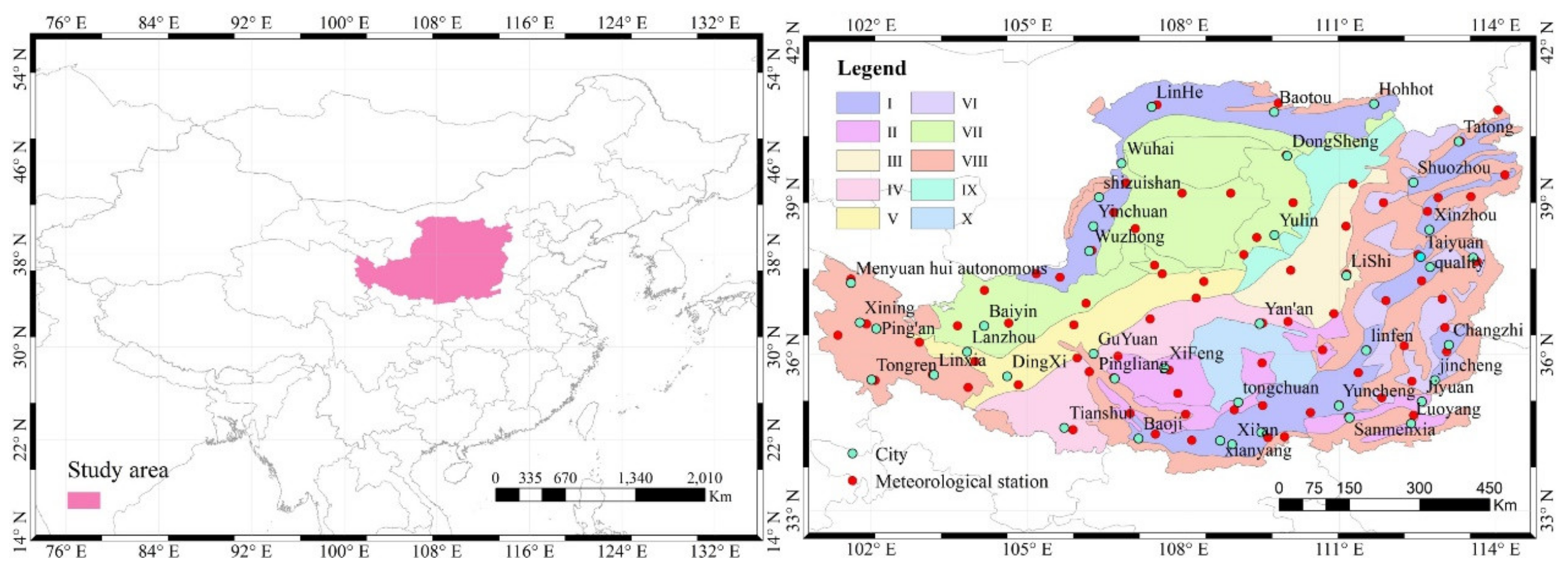

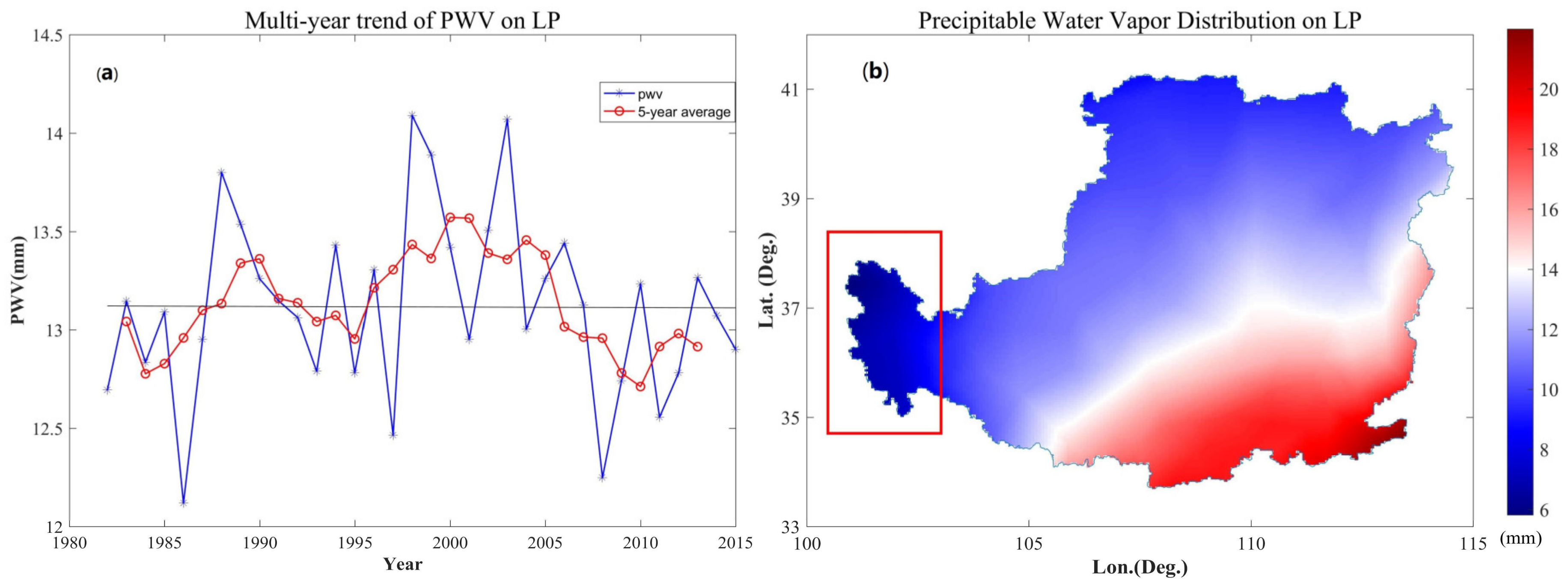
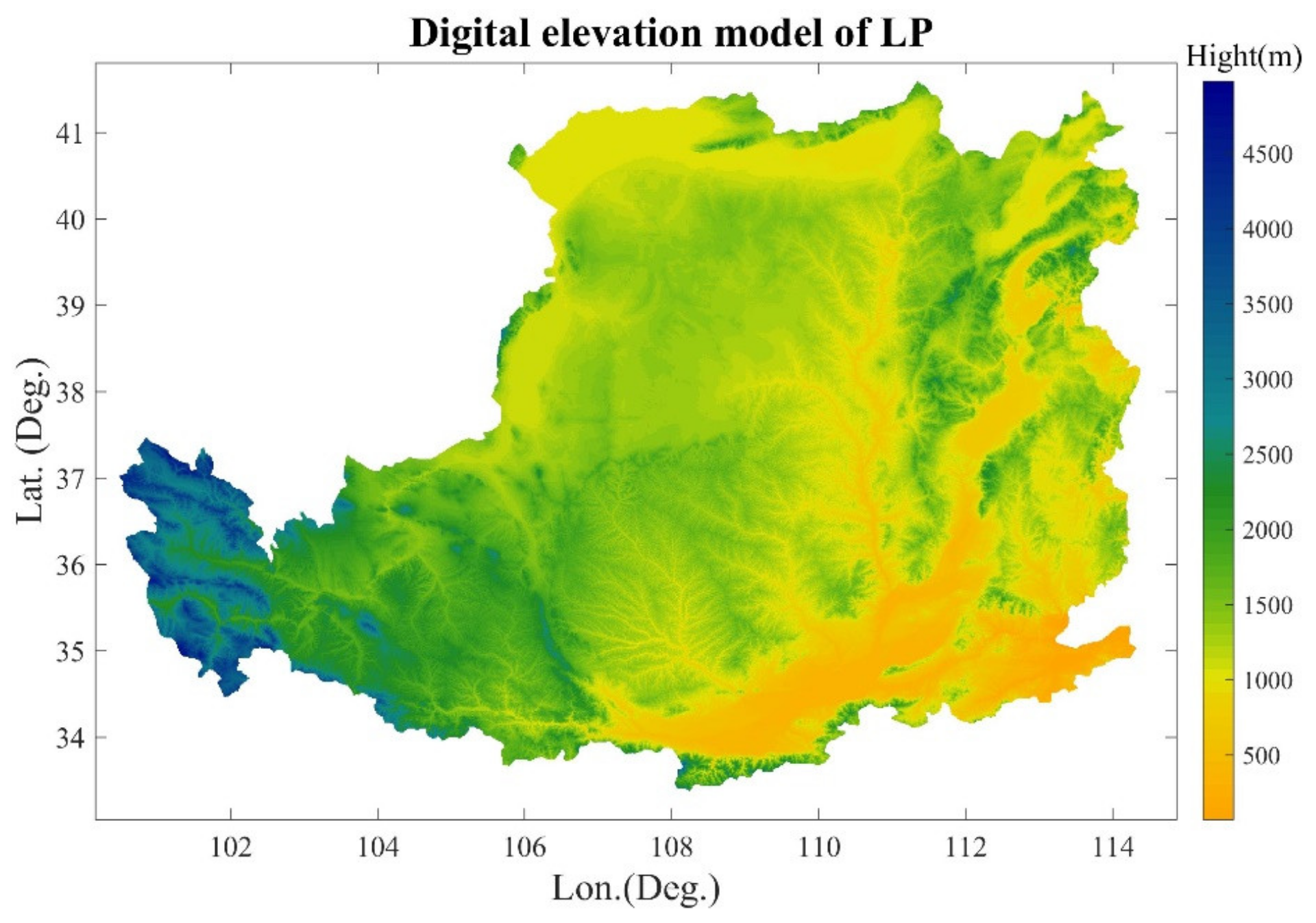
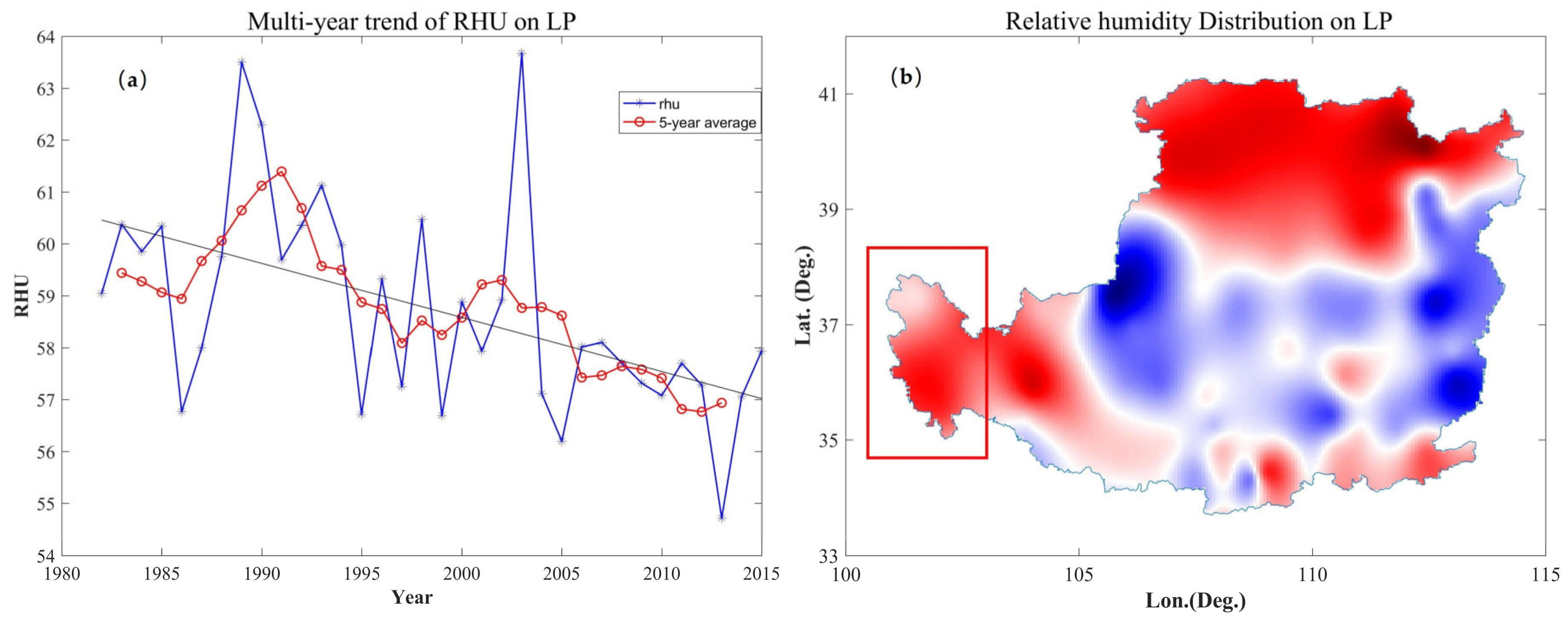
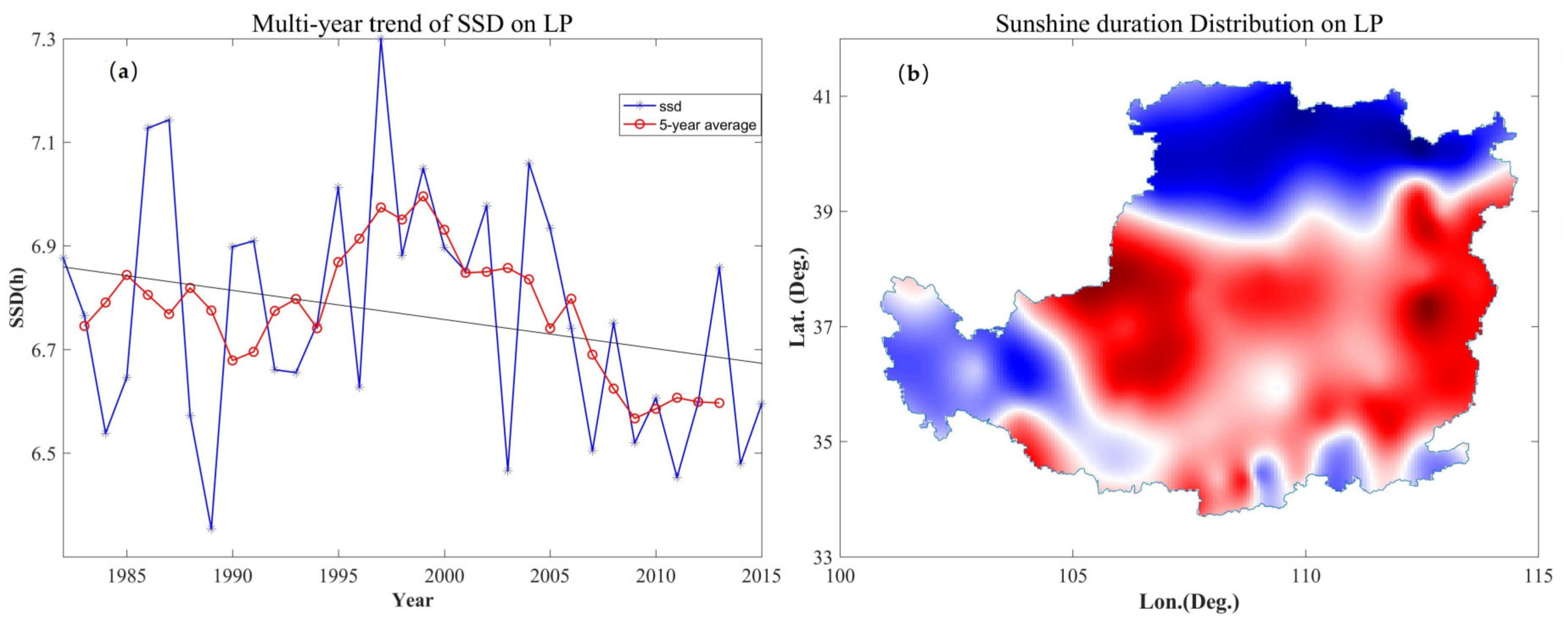

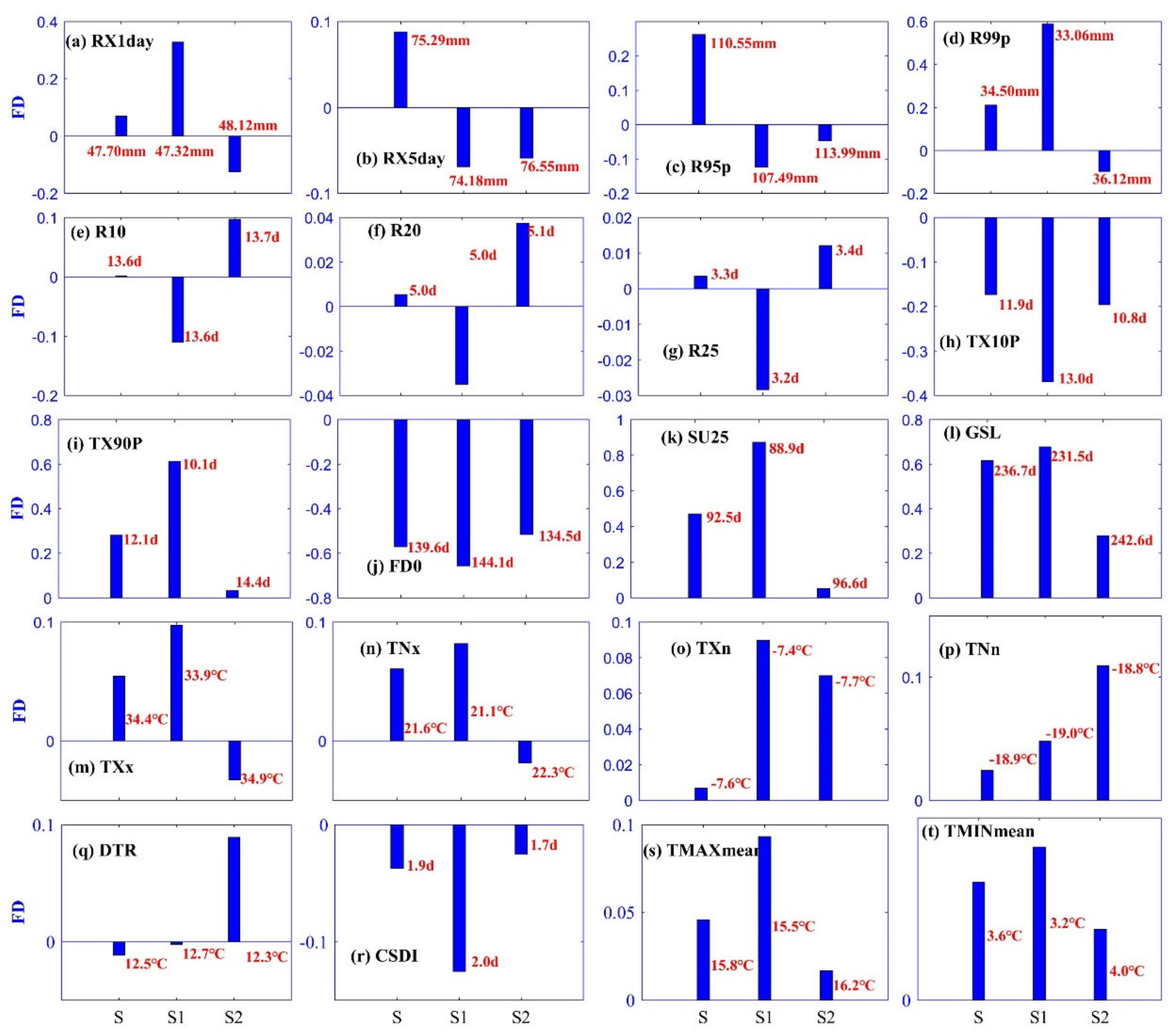

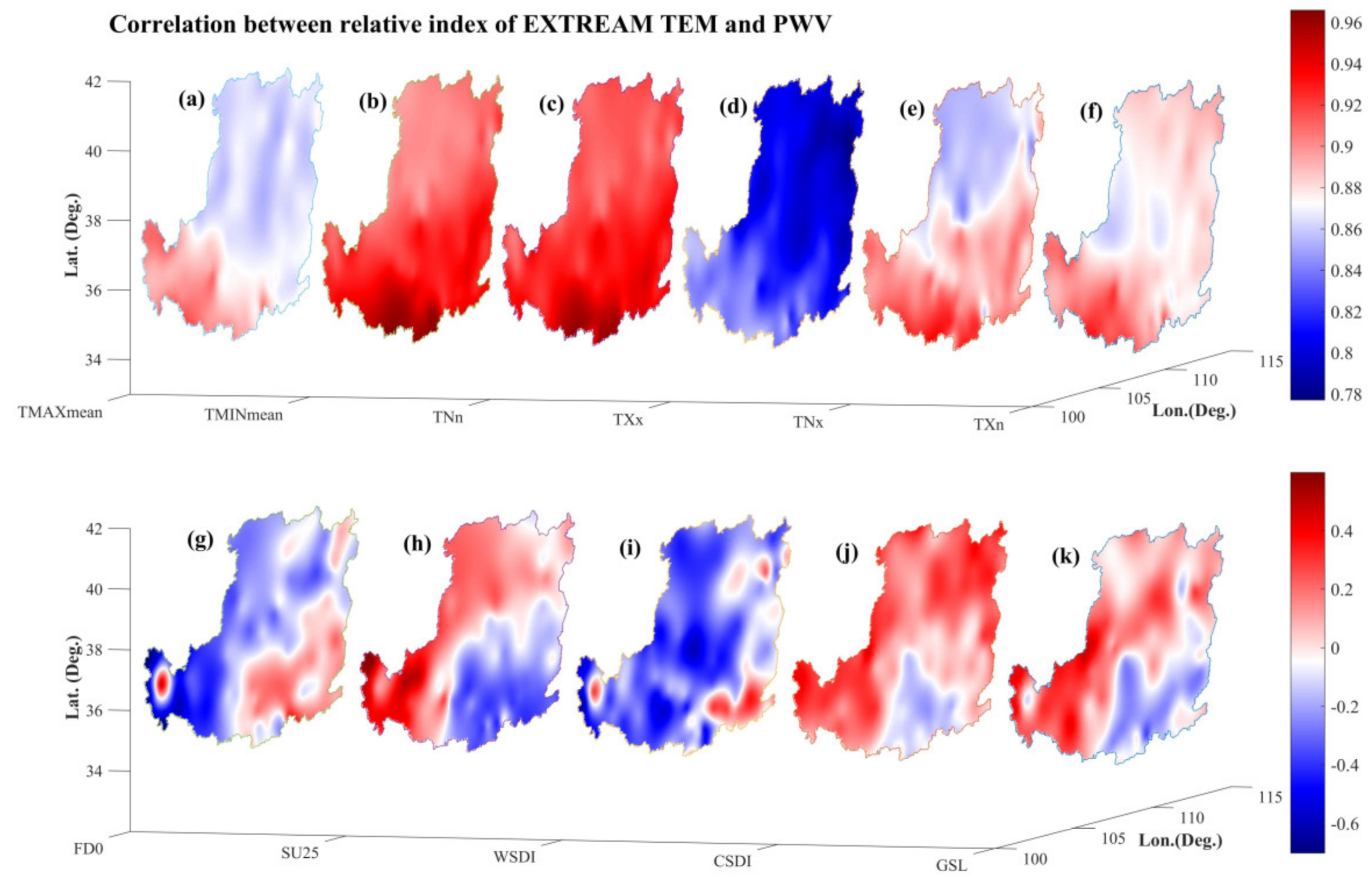
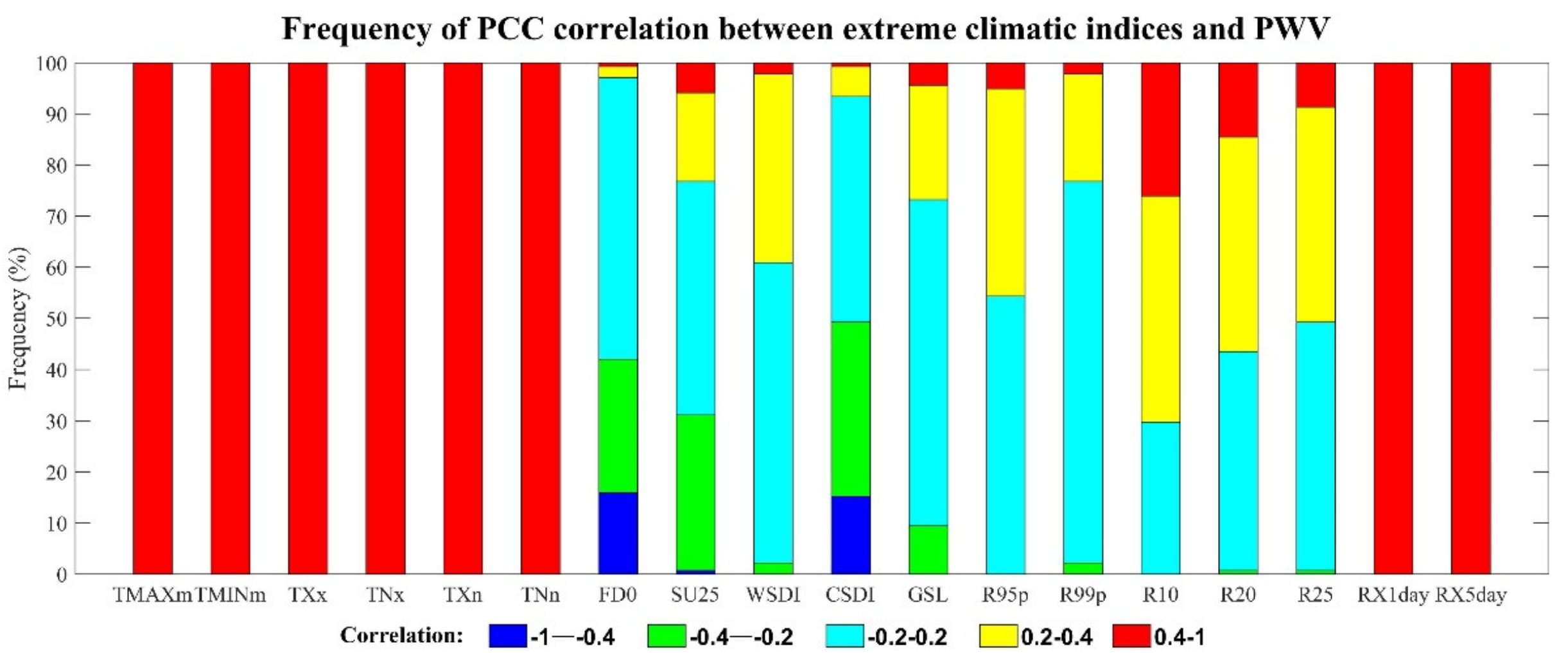
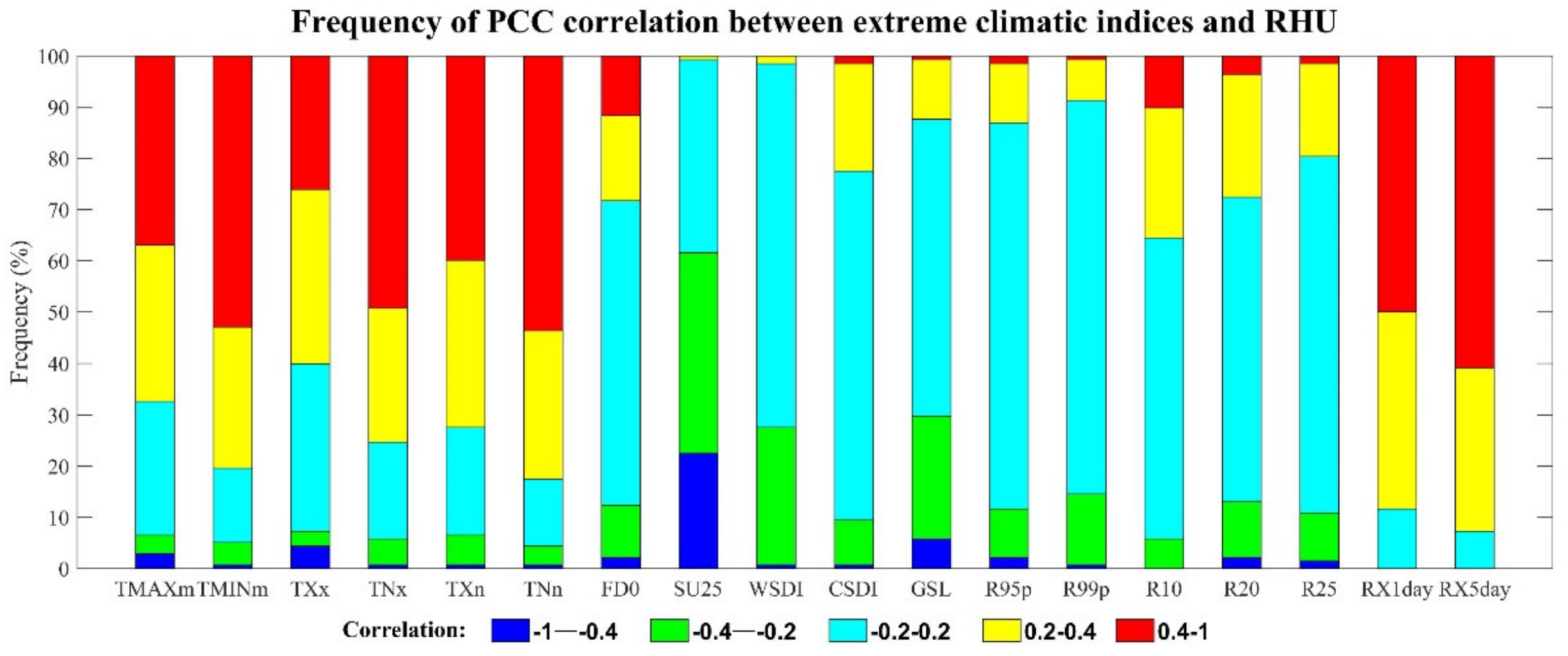
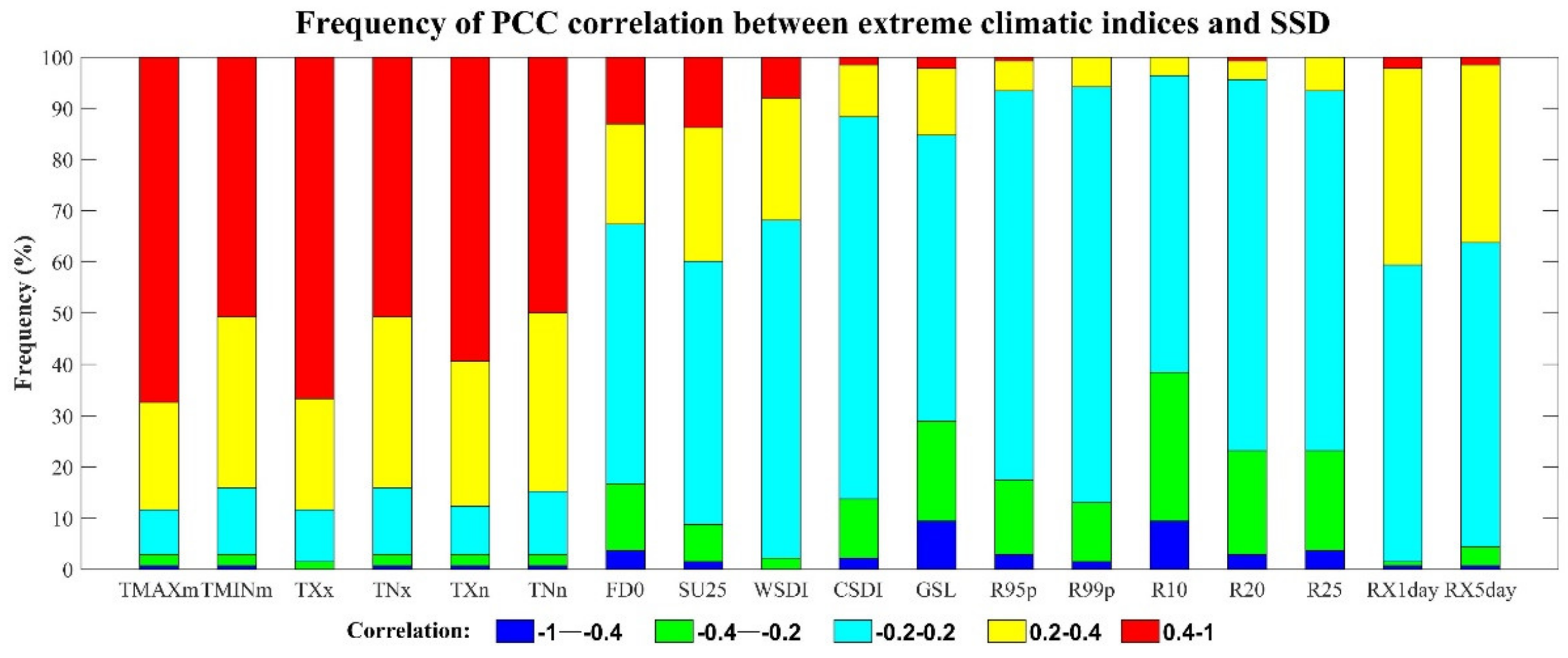

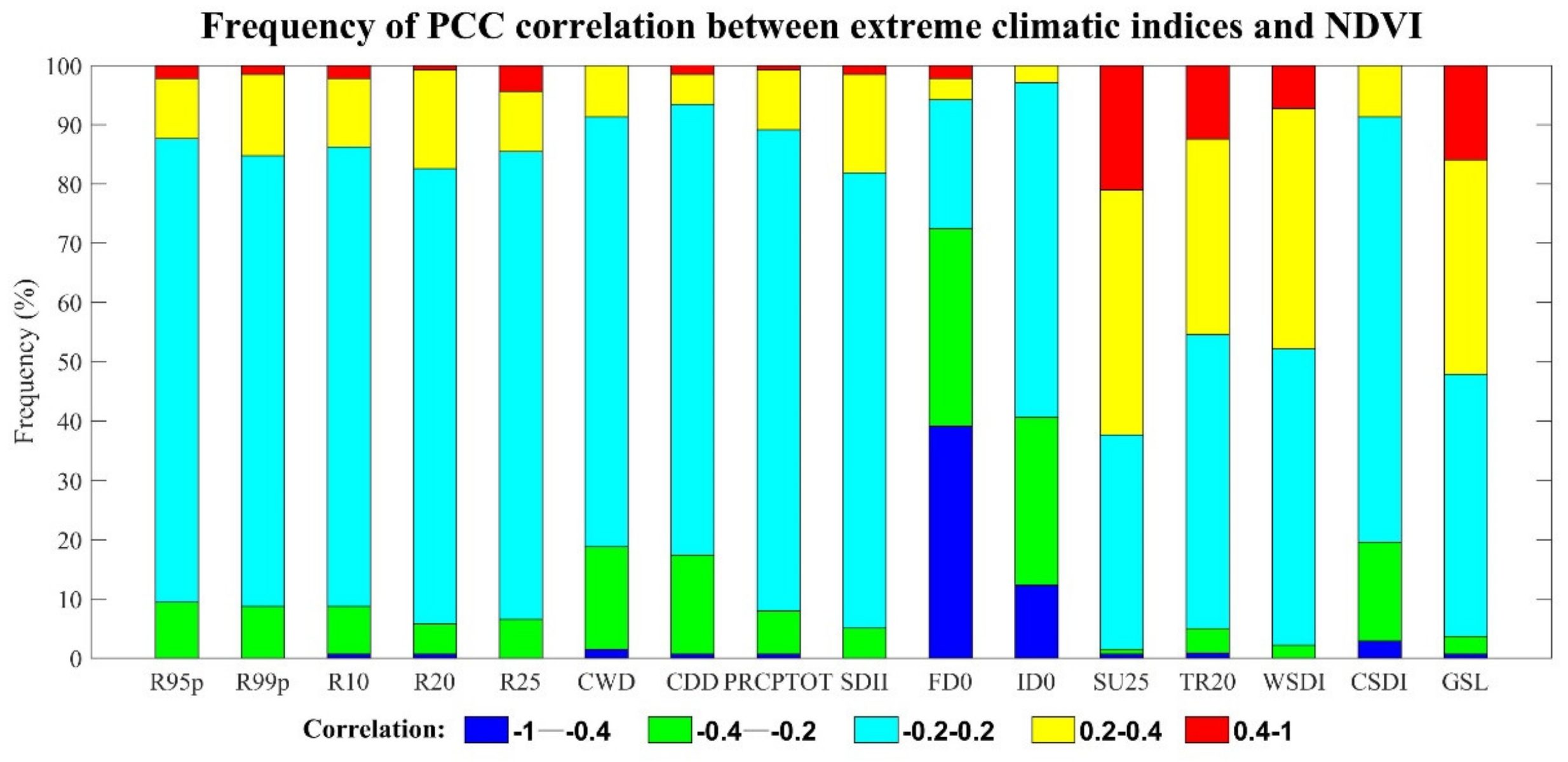
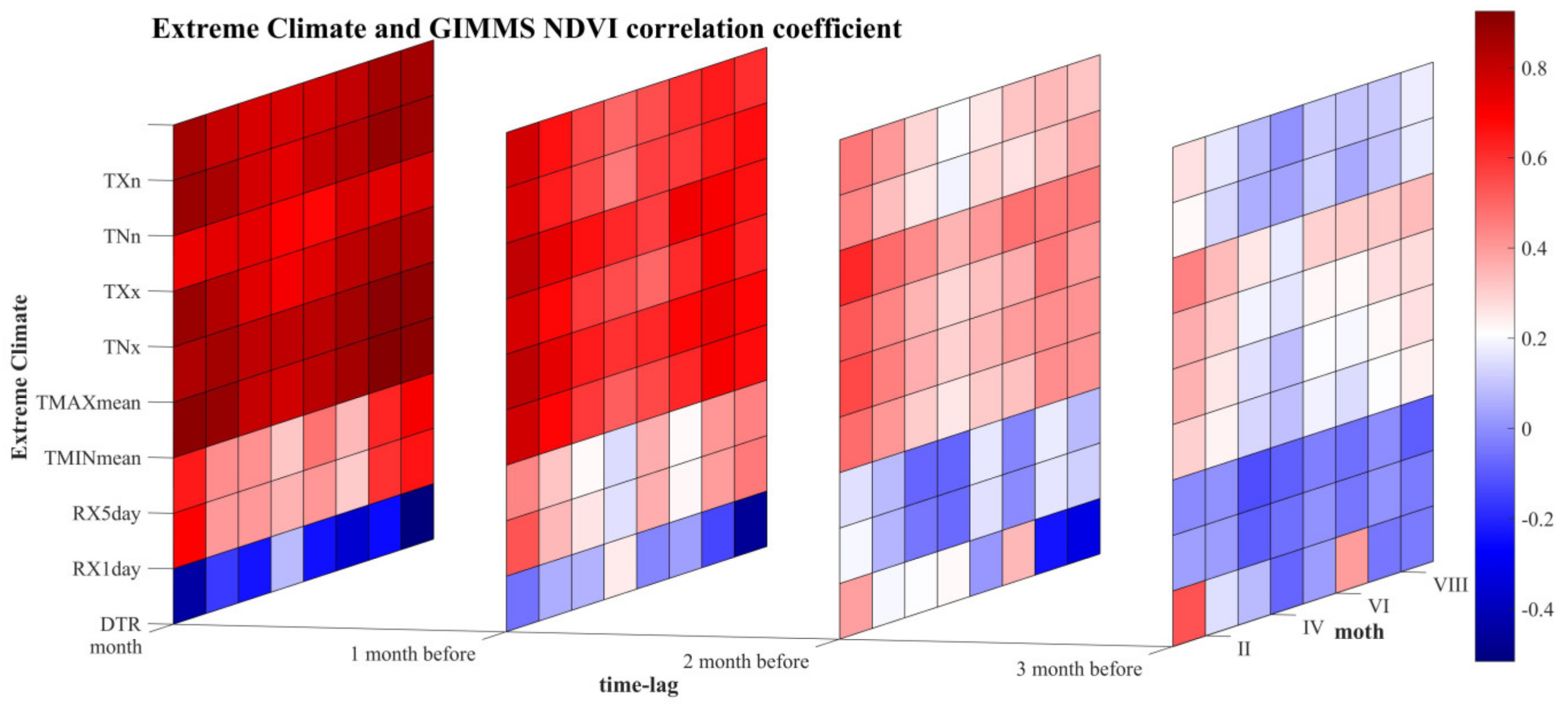
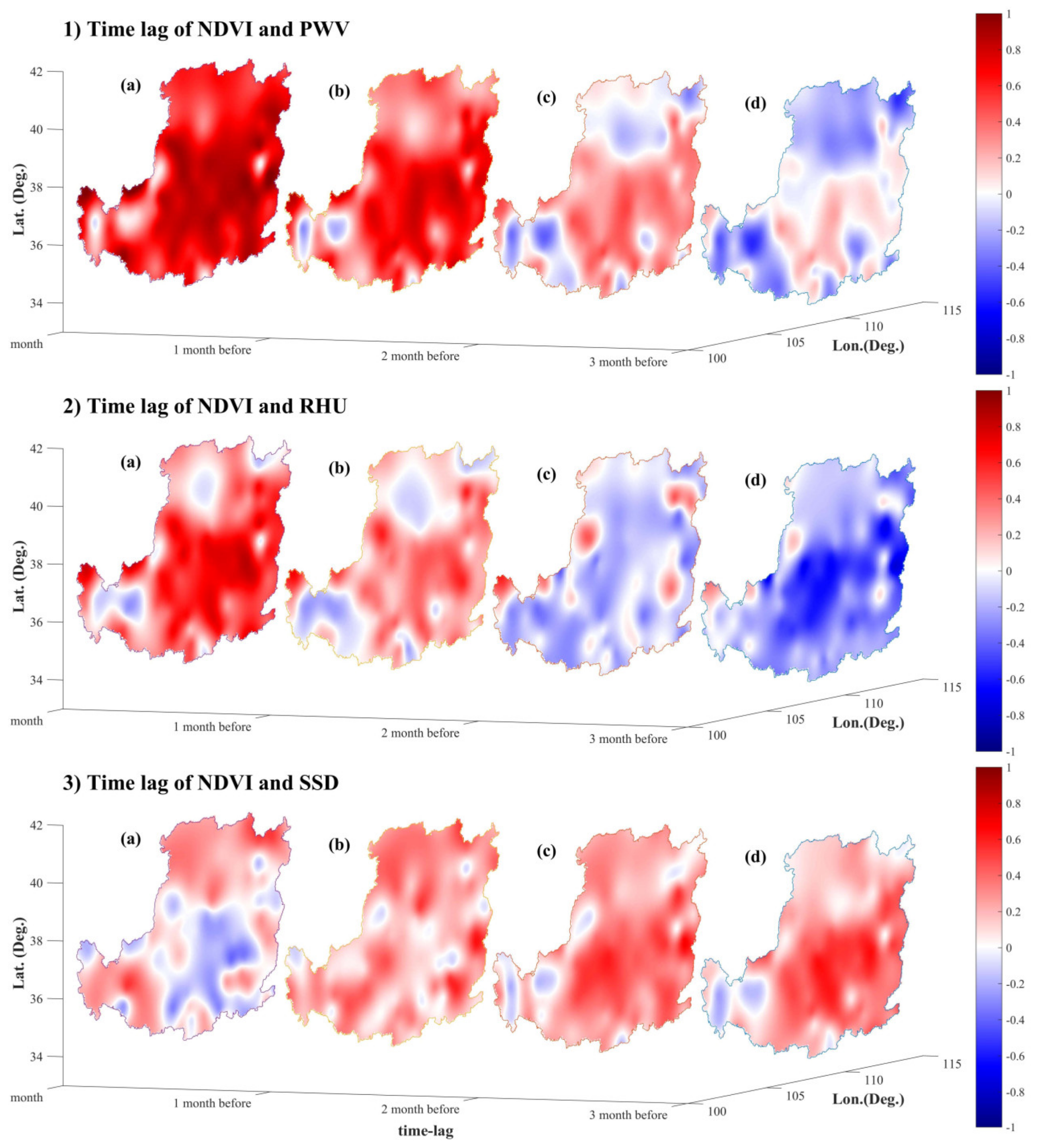
| No. | Geographical Area. | No. | Geographical Area. |
|---|---|---|---|
| Ⅰ | River Impact Plain | Ⅵ | Loess Hills in the Intermountain Basin |
| Ⅱ | Loess Tableland | Ⅶ | Wind Dunes |
| Ⅲ | Loessian Rolling Hills | Ⅷ | Stone Mountain |
| Ⅳ | Loess Beam Hills | Ⅸ | The Sandy Loess Hills |
| Ⅴ | Loess Wide Valley | Ⅹ | Rocky Hills |
| Category | Index Name | Definition | Index Code | Unit | |
|---|---|---|---|---|---|
| Extreme precipitation index | Precipitation index | Maximum 1-d Precipitation | Highest precipitation amount in 1-d period | RX1day | mm |
| Maximum 5-d Precipitation | Highest precipitation amount in the 5-d period | RX5day | mm | ||
| Strong rainfall | Precipitation due to very wet days (> 95th percentile) | R95p | mm | ||
| Super strong rainfall | Precipitation due to extremely wet days (> 99th percentile) | R99p | mm | ||
| Simple daily intensity index | Mean precipitation amount on a wet day | SDII | mm*d−1 | ||
| Total precipitation in wet days (>1 mm) | PRCPTOT | mm | |||
| Precipitation day index | Consecutive dry days | Maximum length of dry spell (RR < 1 mm) | CDD | d | |
| Consecutive wet days | Maximum length of wet spell (RR ≥ 1 mm) | CWD | d | ||
| Heavy precipitation days | Count of days where RR (daily precipitation amount) ≥ 10mm | R10 | d | ||
| Very heavy precipitation days | Count of days where RR ≥ 20mm | R20 | d | ||
| Count of days where RR ≥ 25mm threshold in mm | R25 | d | |||
| Extreme temperature index | Relative index | Cold nights | Count of days where TN < 10th percentile | TX10P | % |
| Cold day-times | Count of days where TX < 10th percentile | TN10P | % | ||
| Warm nights | Count of days where TN > 90th percentile | TX90P | % | ||
| Warm day-times | Count of days where TX > 90th percentile | TN90P * | % | ||
| Adiabatic index | Frost days | Count of days where TN (daily minimum temperature) < 0 °C | FD0 | d | |
| Icing days | Count of days where TX < 0 °C | ID0 | d | ||
| Summer days | Count of days where TX (daily maximum temperature) > 25 °C | SU25 | d | ||
| Tropical nights | Count of days where TN > 20 °C | TR20 | d | ||
| Extreme Value Index | Monthly maximum value of daily maximum temperature | TXx | °C | ||
| Monthly maximum value of daily minimum temperature | TNx | °C | |||
| Monthly minimum value of daily maximum temperature | TXn | °C | |||
| Monthly minimum value of daily minimum temperature | TNn | °C | |||
| Other indicators | Warm spell duration index | Count of days in a span of least six days where TX > 90th percentile | WSDI * | % | |
| Cold spell duration index | Count of days in a span of at least six days where TN > 10th percentile | CSDI | d | ||
| Growing season length | Annual count of days between first span of at least six days where TG (daily mean temperature) > 5 °C and first span in second half of the year of at least six days where TG < 5 °C | GSL | d | ||
| Diurnal temperature range | Mean difference between TX and TN (°C) | DTR | °C | ||
| Range | −1~−0.4 | −0.4~−0.2 | −0.2~0.2 | 0.2~0.4 | 0.4~1 |
|---|---|---|---|---|---|
| Correlation degree | Strong negative correlation | Moderate negative correlation | Weak correlation | Moderate positive correlation | Strong positive correlation |
| Period | Increase | Decrease | |||||
|---|---|---|---|---|---|---|---|
| S | S1 | S2 | S | S1 | S2 | ||
| Significance Level | |||||||
| P < 0.01 | 72.23 | 12.28 | 56.76 | 1.96 | 0.14 | 0.90 | |
| 0.01 < P < 0.05 | 6.38 | 9.64 | 13.68 | 1.05 | 0.53 | 0.72 | |
| 0.05 < P < 0.1 | 2.67 | 6.78 | 16.66 | 0.75 | 0.75 | 0.44 | |
| 0.1 < P | 9.42 | 50.5 | 5.42 | 5.54 | 19.63 | 0.44 | |
| ID | mean | Max-Year | Max | Min-Year | Min | Rate (/10a) | Jump Year |
|---|---|---|---|---|---|---|---|
| FD0 | 139.8 | 1986 | 151.75 | 2015 | 125.68 | 0.59 | 1996 |
| ID0 | 32.00 | 1984 | 50.91 | 2015 | 22.17 | −2.1 | 1990 |
| TX90p | 11.97 | 2002 | 21.29 | 1983 | 5.13 | 119.7 | 2002 |
| TX10p | 11.92 | 1984 | 20.01 | 2016 | 7.32 | 119.2 | 1984 |
| TXx | 34.36 | 2010 | 36.37 | 1989 | 32.56 | 0.48 | 1995 |
| TNx | 21.67 | 2010 | 23.65 | 1993 | 20.25 | 0.55 | 1995 |
| TXn | 7.91 | 1984 | 10.94 | 2015 | 5.21 | −0.8 | —— |
| TNn | 19.02 | 1991 | 22.15 | 2015 | 12.73 | −0.25 | —— |
| GSL | 236.8 | 2016 | 250.70 | 1986 | 220.90 | 5.82 | 2000 |
| DTR | 12.49 | 2014 | 14.40 | 2008 | 9.85 | −0.11 | —— |
| TMAXmean | 15.82 | 2013 | 17.09 | 1984 | 14.18 | 0.46 | 1994 |
| TMINmean | 3.58 | 2016 | 4.64 | 1984 | 2.29 | 0.52 | 1996 |
| RX1day | 48.09 | 2016 | 62.71 | 2015 | 38.74 | 1.2 | —— |
| RX5day | 75.71 | 2013 | 90.48 | 1986 | 58.08 | 1.3 | —— |
| R95p | 112.3 | 2003 | 147.43 | 2015 | 66.59 | 2.1 | —— |
| R99p | 35.81 | 2016 | 70.47 | 2015 | 15.55 | 2.7 | —— |
| R10 | 74.36 | 1999 | 126.27 | 1980 | 50.20 | −0.98 | —— |
| R20 | 4.75 | 1985 | 6.22 | 2012 | 3.75 | −0.32 | —— |
| R25 | 13.65 | 2003 | 18.46 | 1986 | 9.64 | 0.89 | —— |
| Subregion | I | II | III | IV | V | VI | VII | VIII |
|---|---|---|---|---|---|---|---|---|
| Time delay/(month) | 3 | 2 | 0 | 1 | 0 | 3 | 0 | 0 |
© 2020 by the authors. Licensee MDPI, Basel, Switzerland. This article is an open access article distributed under the terms and conditions of the Creative Commons Attribution (CC BY) license (http://creativecommons.org/licenses/by/4.0/).
Share and Cite
Zhao, Q.; Ma, X.; Liang, L.; Yao, W. Spatial–Temporal Variation Characteristics of Multiple Meteorological Variables and Vegetation over the Loess Plateau Region. Appl. Sci. 2020, 10, 1000. https://doi.org/10.3390/app10031000
Zhao Q, Ma X, Liang L, Yao W. Spatial–Temporal Variation Characteristics of Multiple Meteorological Variables and Vegetation over the Loess Plateau Region. Applied Sciences. 2020; 10(3):1000. https://doi.org/10.3390/app10031000
Chicago/Turabian StyleZhao, Qingzhi, Xiongwei Ma, Liang Liang, and Wanqiang Yao. 2020. "Spatial–Temporal Variation Characteristics of Multiple Meteorological Variables and Vegetation over the Loess Plateau Region" Applied Sciences 10, no. 3: 1000. https://doi.org/10.3390/app10031000





